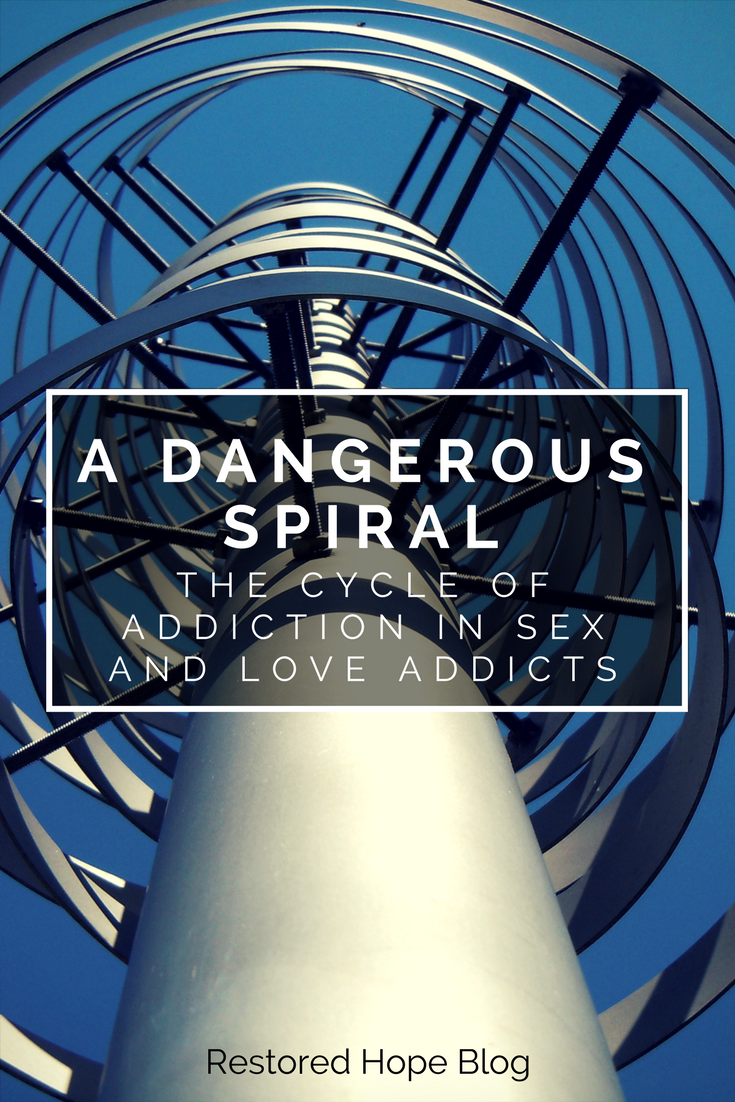Have you ever found yourself in the middle of a familiar pattern of behavior that you promised you would never do again? Maybe it was a series of toxic relationships where you felt drained of life. Maybe you found yourself having one drink too many again, with the raging hangover to prove it. Perhaps you wonder how you managed to polish off another bag of cookies all by yourself.
For the sex and love addict, finding herself in the middle of behaviors she promised she would never return to again is a common occurrence. There’s often a distinctive difference where her “addict” self takes over and their true, authentic self disappears. It seems reminiscent of Dr. Jekyll and Mr. Hyde, where she feels clueless of how the change even happens.
We’ve talked about triggers toward addictive behavior in the past. While triggers can often be the spark that lights the fire, the fire burns brighter and picks up speed as it starts to move through the cycle of addiction introduced by Patrick Carnes in his book, Out of the Shadows.
Beginning the Cycle
The cycle starts when events trigger the addict to experience beliefs rooted in shame. Thoughts like “I am not enough,” “I am too much,” or “There is something wrong with me” can trigger a shame spiral, which leads to painful emotions. The addict can feel the tension of desire to escape from the pain, creating a void she wants to fill. These shame statements can be made worse by feeling hungry, angry, lonely, or tired, which are often results of poor self-care.
Stage 1: Preoccupation and Fantasy
As she tries to cope with the shame and beliefs she’s experiencing, the sex and love addict begins to fantasize about her desired sexual behavior. Sexual behaviors are typically the primary way she has learned to cope with distressing emotions. Eventually, her obsessive thoughts about sex or relationships can feel intrusive and uncontrollable as they continue to pop into her head uninvited. Fantasy about past sexual behavior or the potential of future behaviors can flood her brain with dopamine, a neurochemical in the brain that is a driving factor in sexual addiction.
What does preoccupation and fantasy look like for you?
Stage 2: Ritual
Next, the addict begins to prepare to engage in her sexual behavior. In this stage, the addict begins to disconnect from the world around her. Time can pass in a rush, responsibilities can be ignored or forgotten, and she moves in autopilot, energy coursing through her body as a result of the flood of neurochemicals in her brain. She may prepare to meet sexual partners by dressing up and putting on makeup, driving to a bar, or opening a hookup app on her phone. If her addictive behavior is based online, even opening a computer can serve as a ritual. The emotional “high” from engaging in these rituals is typically more sexually charged than the sexual behavior itself.
What are your rituals?
Stage 3: Compulsive Sexual Behavior
Stages 1 and 2 set the addict on a crash course toward what is referred to as “acting out behavior,” or the compulsive sexual behavior in which the addict engages. Once the cycle has started, this behavior can feel inevitable, especially if she isn't aware of the process of ritual and preoccupation. While to the outsider this stage might look like the goal of the cycle of addiction, in reality it serves as the activity that brings the thrill or high to a halt. In fact, many addicts look forward to and prolong the ritual stage for as long as possible so they don’t break the high of the behavior.
How would you define this problem behavior in your life?
Stage 4: Despair
When the addict acts out, she then experiences both relief and shame. The relief comes from masking the distressing emotions she felt that drove the behavior, but it is often quickly followed by shame surrounding the failure to resist acting out. Sadly, that shame can reinforce the beliefs about herself that initially led the addict to become triggered in the first place.
She might try to numb out or disengage from those feelings through other addictive behaviors, such as alcohol, drugs, food, cleaning, religious activities, shopping, or focusing on children. But the easiest way to deal with that guilt and shame that arises is to return to the sexual acting out to mask those feelings once again. The underlying issues that started the addictive cycle in the first place (the shame and negative core beliefs that started the spiral downward) are left unaddressed.
What do you tend to do to make your despair or shame go away?
Jumping Off the Cycle
You cannot break this cycle by just telling yourself to stop. It is crucially important to examine how your personal version of the cycle looks so that you’re able to recognize when you’re headed toward a downfall. The cycle can only be addressed when you start at the root: the underlying core beliefs and triggers that led you there in the first place.
Start noticing the events, thoughts, and emotions you have prior to your fantasy or preoccupation starting. What do you believe about yourself or about the world around you? When you notice that shame arising, slow down and practice self-care. Journal or call up a trusted friend who can help you sort through what you’re experiencing. Look for alternative behaviors to meet the needs that are driving your desire to act out. Examine those emotions or experiences in a healthy way with your therapist, and you’ll begin to notice the drive to escape is not as powerful as you once thought.



